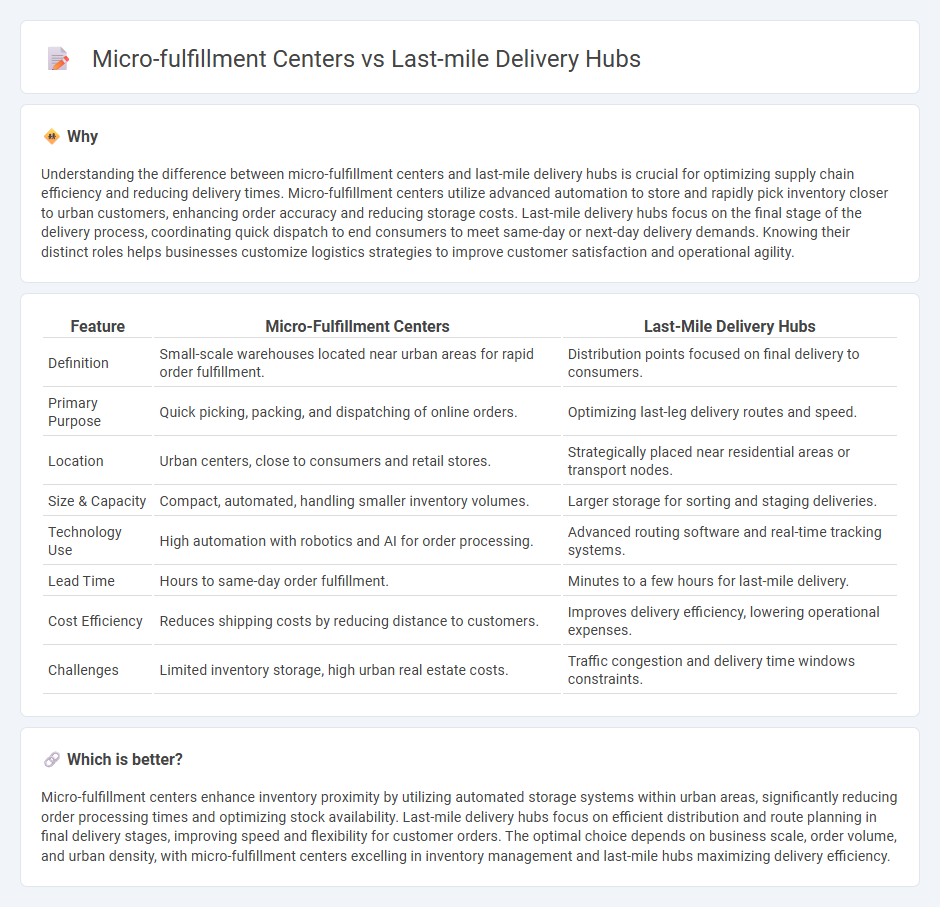
Micro-fulfillment centers leverage automation to enhance inventory storage and order processing speed within urban areas, reducing delivery times significantly. Last-mile delivery hubs serve as strategic points to consolidate shipments and facilitate rapid final-mile distribution to customers. Explore how these two logistics models optimize supply chain efficiency and customer satisfaction.
Why it is important
Understanding the difference between micro-fulfillment centers and last-mile delivery hubs is crucial for optimizing supply chain efficiency and reducing delivery times. Micro-fulfillment centers utilize advanced automation to store and rapidly pick inventory closer to urban customers, enhancing order accuracy and reducing storage costs. Last-mile delivery hubs focus on the final stage of the delivery process, coordinating quick dispatch to end consumers to meet same-day or next-day delivery demands. Knowing their distinct roles helps businesses customize logistics strategies to improve customer satisfaction and operational agility.
Comparison Table
| Feature | Micro-Fulfillment Centers | Last-Mile Delivery Hubs |
|---|---|---|
| Definition | Small-scale warehouses located near urban areas for rapid order fulfillment. | Distribution points focused on final delivery to consumers. |
| Primary Purpose | Quick picking, packing, and dispatching of online orders. | Optimizing last-leg delivery routes and speed. |
| Location | Urban centers, close to consumers and retail stores. | Strategically placed near residential areas or transport nodes. |
| Size & Capacity | Compact, automated, handling smaller inventory volumes. | Larger storage for sorting and staging deliveries. |
| Technology Use | High automation with robotics and AI for order processing. | Advanced routing software and real-time tracking systems. |
| Lead Time | Hours to same-day order fulfillment. | Minutes to a few hours for last-mile delivery. |
| Cost Efficiency | Reduces shipping costs by reducing distance to customers. | Improves delivery efficiency, lowering operational expenses. |
| Challenges | Limited inventory storage, high urban real estate costs. | Traffic congestion and delivery time windows constraints. |
Which is better?
Micro-fulfillment centers enhance inventory proximity by utilizing automated storage systems within urban areas, significantly reducing order processing times and optimizing stock availability. Last-mile delivery hubs focus on efficient distribution and route planning in final delivery stages, improving speed and flexibility for customer orders. The optimal choice depends on business scale, order volume, and urban density, with micro-fulfillment centers excelling in inventory management and last-mile hubs maximizing delivery efficiency.
Connection
Micro-fulfillment centers are strategically located small-scale warehouses designed to expedite order processing close to urban areas, directly feeding last-mile delivery hubs that manage the final dispatch to customers. These hubs optimize delivery routes and reduce transit times, enhancing overall supply chain efficiency and customer satisfaction. The integration of both facilities leverages technology such as automation and real-time data analytics to streamline inventory management and accelerate delivery speeds.
Key Terms
Location proximity
Last-mile delivery hubs are strategically located near urban centers to ensure rapid customer delivery, optimizing speed and reducing transportation costs. Micro-fulfillment centers, often embedded within or close to large retail stores, focus on minimizing average travel distance for order preparation by leveraging high-density, localized inventory storage. Explore how these proximity strategies reshape supply chain efficiency and consumer satisfaction.
Inventory scale
Last-mile delivery hubs typically handle smaller, region-focused inventory optimized for rapid order fulfillment within urban or suburban areas, enabling quick delivery to customers. Micro-fulfillment centers maintain a larger inventory scale than last-mile hubs, leveraging automated systems to stock a broader variety of products, which supports higher order volumes and diverse SKU availability. Explore the differences in inventory management and operational efficiency between these facilities to enhance your supply chain strategy.
Order fulfillment speed
Last-mile delivery hubs are strategically located near urban centers to ensure rapid order dispatch and reduced transit times, enhancing overall delivery speed. Micro-fulfillment centers utilize automated systems and compact storage solutions within urban warehouses to accelerate order picking and packing processes directly within or near stores. Explore how integrating both can optimize order fulfillment speed and improve customer satisfaction.
Source and External Links
Urban Delivery Hubs Present Solutions to Final-Mile Shipping - Urban delivery hubs are established near city outskirts to facilitate the transfer of goods from longhaul drivers to local delivery services, reducing cost and complexity in final-mile delivery within metro areas.
C.9 - Last Mile Facilities - Last-mile delivery hubs include fast delivery hubs, delivery stations, and micro-hubs that support quick, localized distribution often using small electric vehicles or cargo bikes to improve speed and environmental impact in urban areas.
What is a Last-Mile Delivery Station? - Last-mile delivery stations act as local hubs where packages from larger centers are sorted and dispatched for faster, more accurate deliveries, enabling same-day or same-hour service and improving the customer experience.
 dowidth.com
dowidth.com